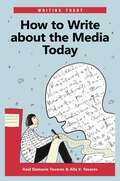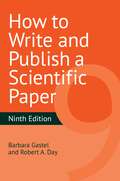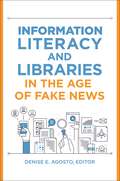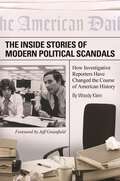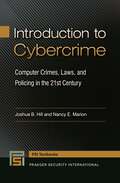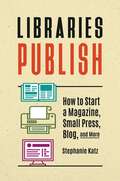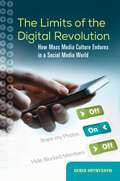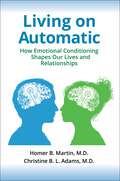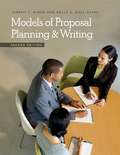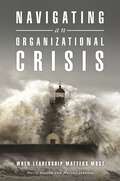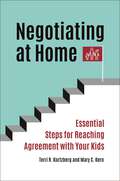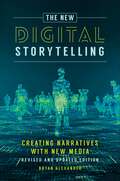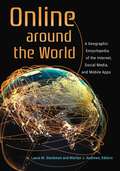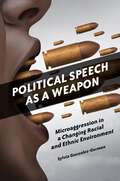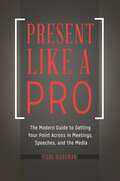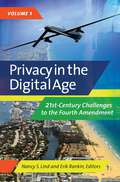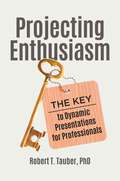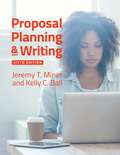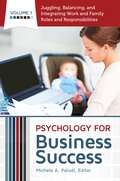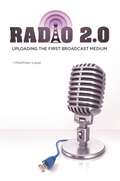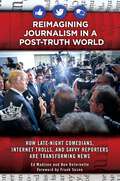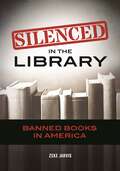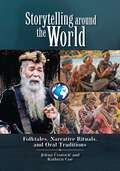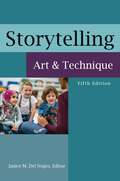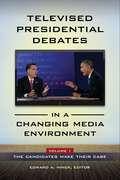- Table View
- List View
How to Write about the Media Today (Writing Today)
by Raúl Damacio Tovares Alla V. TovaresA comprehensive and practical guide to writing a successful media paper or report, from selecting a topic to submitting the final draft.How to Write about the Media Today is the first book to offer students and media practitioners a comprehensive approach for researching and preparing a report, paper, or presentation on some aspect of today's mass communication. How to Write about the Media Today begins with a discussion of different types of media outlets—from traditional newspapers and television to the Internet—as well as an overview of contemporary directions in media studies. This is followed by a series of step-by-step strategies for selecting topics, conducting research, and writing cogently and engagingly about media-related events and issues. Because each chapter stands on its own, this resource can be read sequentially or consulted topic-by-topic as needed.
How to Write and Publish a Scientific Paper
by Barbara Gastel Robert A. DayThoroughly updated throughout, this classic, practical text on how to write and publish a scientific paper takes its own advice to be "as clear and simple as possible.""The purpose of scientific writing," according to Barbara Gastel and Robert A. Day, "is to communicate new scientific findings. Science is simply too important to be communicated in anything other than words of certain meaning."This clear, beautifully written, and often funny text is a must-have for anyone who needs to communicate scientific information, whether they're writing for a professor, other scientists, or the general public. The thoughtfully revised 9th edition retains the most important material-including preparing text and graphics, publishing papers and other types of writing, and plenty of information on writing style-while adding up-to-date advice on copyright, presenting online, identifying authors, creating visual abstracts, and writing in English as a non-native language.A set of valuable appendixes provide ready reference, including words and expressions to avoid, SI prefixes, a list of helpful websites, and a glossary. Students and working scientists will want to keep How to Write and Publish a Scientific Paper at their desks and refer to it at every stage of writing and publication.
Information Literacy and Libraries in the Age of Fake News
by Denise E. Agosto, EditorGoing beyond the fake news problem, this book tackles the broader issue of teaching library users of all types how to become more critical consumers and sharers of information.As a public, school, or academic librarian or educator, you can help library users to become more conscious and responsible consumers of information. As you read, you'll gain a better understanding and appreciation of the core concepts involved in promoting critical information literacy, such as information ethics, media literacy, and civic education. You'll also learn the history of fake news and come away with practical ideas in mind for strategies to apply in your library.Chapters contributed by leading experts in public, academic, and school library services are written in plain, everyday language that librarians and library school students can easily understand and relate to their own experiences as information users, especially their experiences in social media and other online venues where sharing false information takes only a click.
The Inside Stories of Modern Political Scandals: How Investigative Reporters Have Changed the Course of American History
by Woody KleinThis book examines ten major political scandals involving the White House in the past 50 years, revealing how the investigative reporters behind the stories uncovered the hidden truths.On numerous occasions, the dogged efforts of investigative journalists have led to a dissemination of information that had a direct effect on the course of American history—the Bay of Pigs fiasco, the Watergate scandal, "Monicagate" of the Clinton administration, and the Enron accounting scandal.The Inside Stories of Modern Political Scandals: How Investigative Reporters Have Changed the Course of American History features in-depth interviews with all living journalists responsible for revealing major political scandals involving the White House, including Bob Woodward and Carl Bernstein, the reporters responsible for bringing the Watergate scandal to the light of day. The author presents a fascinating view into the "story behind the story" regarding the ten most momentous, modern-day political scandals in America. Containing both anecdotes from the investigative reporters involved and specific examples from published articles, this text reveals the specific methods used by these award-winning journalists to successfully pursue their stories and earn their titles as watchdogs of our government, our military, and big business.
Introduction to Cybercrime: Computer Crimes, Laws, and Policing in the 21st Century (Praeger Security International Textbook)
by Joshua B. Hill Nancy E. MarionExplaining cybercrime in a highly networked world, this book provides a comprehensive yet accessible summary of the history, modern developments, and efforts to combat cybercrime in various forms at all levels of government—international, national, state, and local.As the exponential growth of the Internet has made the exchange and storage of information quick and inexpensive, the incidence of cyber-enabled criminal activity—from copyright infringement to phishing to online pornography—has also exploded. These crimes, both old and new, are posing challenges for law enforcement and legislators alike. What efforts—if any—could deter cybercrime in the highly networked and extremely fast-moving modern world? Introduction to Cybercrime: Computer Crimes, Laws, and Policing in the 21st Century seeks to address this tough question and enables readers to better contextualize the place of cybercrime in the current landscape.This textbook documents how a significant side effect of the positive growth of technology has been a proliferation of computer-facilitated crime, explaining how computers have become the preferred tools used to commit crimes, both domestically and internationally, and have the potential to seriously harm people and property alike. The chapters discuss different types of cybercrimes—including new offenses unique to the Internet—and their widespread impacts. Readers will learn about the governmental responses worldwide that attempt to alleviate or prevent cybercrimes and gain a solid understanding of the issues surrounding cybercrime in today's society as well as the long- and short-term impacts of cybercrime.
Libraries Publish: How to Start a Magazine, Small Press, Blog, and More
by Stephanie KatzIn this book, author Stephanie Katz, founding editor of the award-winning literary journal 805 Lit + Art, shares practical tools and advice for starting successful creative publishing projects.Publishing benefits libraries by providing high-quality content to patrons, showcasing local writers and faculty, and creating buzz for the library. These endeavors can be launched at any type and size of library, often for little to no cost. Libraries Publish teaches libraries how to publish literary magazines, book review blogs, local anthologies, picture books, library professional journals, and even novels. You'll learn how to run a writing contest or writer-in-residence program, form community partnerships with other literary organizations, find funding, navigate legal considerations, market your publication, and more. Each chapter contains detailed information on how to start your project, including comprehensive checklists, recommendations for free software, and legal considerations. Social media strategies as well as tips for facilitating student or teen-run projects are also covered. If your library wants to start a publishing project, this book will be your go-to resource!
The Limits of the Digital Revolution: How Mass Media Culture Endures in a Social Media World
by Derek HrynyshynThis academic analysis explores social media, specifically examining its influence on the cultural, political, and economic organization of our society and the role capitalism plays within its domain.In this examination of society and technology, author and educator Derek Hrynyshyn explores the ways in which social media shapes popular culture and how social power is expressed within it. He debunks the misperception of the medium as a social equalizer—a theory drawn from the fact that content is created by its users—and compares it to mass media, identifying the capitalist-driven mechanisms that drive both social media and mass media. The work captures his assessment that social media legitimizes the inequities among the social classes rather than challenging them.The book scrutinizes the difference between social media and mass media, the relationship between technologies and social change, and the role of popular culture in the structure of political and economic power. A careful look at social media networks such as Facebook, Twitter, and Google suggests that these tools are systems of surveillance, monitoring everyday activities for the benefit of advertisers and the networks themselves. Topics covered within the book's 10 detailed chapters include privacy online, freedom of expression, piracy, the digital divide, fragmentation, and social cohesion.
Living on Automatic: How Emotional Conditioning Shapes Our Lives and Relationships
by Homer B. MD Christine B. MDTwo veteran psychiatrists unravel the mystery of how thought and emotional patterns are passed from parents to children, generation after generation, "conditioning" each of us in ways that endure throughout our lives and affect all of our relationships.Living on Automatic not only introduces the concept of emotional conditioning, including how it occurs and becomes entrenched in our minds, but also explains how individuals can "decondition" themselves to become more adept at choosing and negotiating more rewarding relationships. Authored by two psychiatrists, the text draws from more than 80 years of their combined psychotherapy work with thousands of people. The authors focus on helping readers to understand their roles in relationships and to develop more rewarding relationships. Case studies and questions are provided to illustrate emotional conditioning and the personality roles that emerge from it. Readers will learn why people choose the mates that they do; why the ways we learn to relate as children often do not change later in life; and how to observe and engage in introspection to begin to decondition themselves from auto-pilot, knee-jerk emotional responses, allowing for the formation of better relationships with their spouse or partner, children, and other family members.
Models of Proposal Planning & Writing
by Jeremy T. Miner Kelly C. Ball-StahlThis book is an essential weapon for anyone looking for funding in the extremely competitive grantseeking world. It explains how and why to approach both public and private sponsors with not just information, but persuasion, for the best chance for success.How do you present the right balance of logic, emotion, and relationship-awareness to make a persuasive proposal? What is THE most important thing to do before submitting a proposal to increase your odds for funding success? What portion of the proposal must be stressed even when it has a low point value assigned to it in the reviewer's evaluation form? How can a site visit make or break the fate of a meticulously prepared application? Models of Proposal Planning & Writing: Second Edition answers all these critical questions and more for grantseekers, documenting how to write a proposal that will persuade a sponsor to invest in your projects and organization—and just as importantly, explaining why a properly persuasive application puts forth a seamless argument that stands the test of reason, addresses psychological concerns, and connects your project to the values of the sponsor. The book's comprehensive annotations provide practical information that walks readers step-by-step through a logical, integrated process of planning and writing persuasive proposals.
Navigating an Organizational Crisis: When Leadership Matters Most
by Harry Hutson Martha JohnsonHow are leaders facing a crisis supposed to handle and overcome an unknowable set of issues? This book demonstrates how effective leaders under pressure work from an understanding of the situation at hand and of their impact on others, and explains how leaders can best apply their internal strengths.Most leaders are steeped in risk management, crisis response tactics, readiness for disaster, continuity-of-operations planning, and logistical and agility capabilities. These preparations are critical but not complete. The reality is that even experienced leaders themselves need guidance when it comes to managing a crisis. This standout book fills that need, drawing on interviews with successful leaders; research findings on trauma, neuroscience, and crisis management; and the authors' own extensive career experiences. The chapters suggest and probe ideas from various angles rather than promoting simplistic formulas or nostrums that are unlikely to apply to all circumstances and present new angles on self-awareness and management under pressure for the practitioner.The book leads off with a description of organizational disaster and crisis leadership—topics of considerable concern as disasters are becoming the "new normal." The authors then explore three critical but very different types of responses by leaders at such a time: recognition and response, care of self and others, and storytelling. A detailed case study of a leader in the midst of Hurricane Katrina—the most expensive natural disaster in U.S. history—provides readers with a real-world practicum for the theories and ideas suggested.
Negotiating at Home: Essential Steps for Reaching Agreement with Your Kids
by Terri R. Kurtzberg Mary C. KernWhy do parents who can pull off multi-million dollar deals at work then go home and stumble with their kids?Parents spend an awful lot of time negotiating with their kids—over everyday requests, rules and policies, and big decisions, and often end up derailed and frustrated. In Negotiating at Home, Kurtzberg and Kern offer parents a chance to look more closely at what they already do well (and why) and what can be done better. Grounded in decades of research on how to negotiate effectively, parents will learn about how to plan, recognize specific tactics, communicate and work in partnerships with other family members, address fairness, and handle conflict.
The New Digital Storytelling: Creating Narratives with New Media--Revised and Updated Edition
by Bryan AlexanderNewly revised and updated, this is the essential guide to state-of-the-art digital storytelling for audiences, creators, and teachers.Written for everyone interested in the communication potential of digital media, including educators, marketers, communication professionals, and community activists, this is the ultimate guide to harnessing technology for storytelling. No other book covers the digital storytelling movement as thoroughly as this updated second edition of a popular work, nor does any incorporate as many technologies, from video to augmented reality, mobile devices to virtual reality.The book combines history, analysis, and practical guidance about digital storytelling. It begins with a history that encompasses an exploration of storytelling itself, as well as a description of narratives using digital tools from the 1980s through 2000. From there, the author dives into modern digital storytelling, offering analysis and guidance regarding the use of digital video, podcasting, social media, gaming, mobile devices, and virtual and augmented reality. The work concludes with practical advice about how to create and share digital stories using the most current tools so even the new would-be storyteller can create their first digital narrative. Of course, the second edition is updated to take into account the many ways the field has advanced since the original book appeared. With many new examples of digital stories, this edition's evidence base is current and fresh. New or transformed technologies are also addressed, including virtual reality; mobile devices that have become mainstream tools for creating, sharing, and experiencing digital stories; and the wide variety of new storytelling apps and services.
Online around the World: A Geographic Encyclopedia of the Internet, Social Media, and Mobile Apps
by Laura M. Steckman and Marilyn J. Andrews, EditorsCovering more than 80 countries around the world, this book provides a compelling, contemporary snapshot of how people in other countries are using the Internet, social media, and mobile apps.How do people in other countries use the social media platform Facebook differently than Americans do? What topics are discussed on the largest online forum—one in Indonesia, with more than seven million registered users? Why does Mongolia rate in the top-ten countries worldwide for peak Internet speeds? Readers of Online around the World: A Geographic Encyclopedia of the Internet, Social Media, and Mobile Apps will discover the answers to these questions and learn about people's Internet and social media preferences on six continents—outside of the online community of users within the United States. The book begins with an overview of the Internet, social media platforms, and mobile apps that chronologically examines the development of technological innovations that have made the Internet what it is today. The country-specific entries that follow the overview provide demographic information and describe specific events influenced by online communications, allowing readers to better appreciate the incredible power of online interactions across otherwise-unconnected individuals and the realities and peculiarities of how people communicate in today's fast-paced, globalized, and high-technology environment. This encyclopedia presents social media and the Internet in new light, identifying how the use of language and the specific application of human culture impacts emerging technologies and communications, dramatically affecting everything from politics to social activism, education, and censorship.
Political Speech as a Weapon: Microaggression in a Changing Racial and Ethnic Environment
by Sylvia Gonzalez-GormanProvides a penetrating examination of how political rhetoric from public officials creates tensions via microaggression cues due to changing demographics, campaign rhetoric, and the use of social media.What are microaggression cues, and what are examples of those cues in political rhetoric? How have microaggression cues from former presidents, elected officials, political candidates, and former candidate, now President, Trump led to further polarization of America's citizens? What are the connections between these microaggression cues, the demographic shift of the United States, and the growing fear among longtime majority populations?Political Speech as a Weapon: Microaggression in a Changing Racial and Ethnic Environment answers these questions and helps readers understand related topics such as nativism, the transformation process of the U.S. population and cultural norms, and how Americans can best respond to evolving conditions to meet these challenges. Author Sylvia Gonzalez-Gorman addresses a blind spot in the field of American politics and connects hostile rhetoric by public officials to the effect of such rhetoric, which leads to the marginalization of groups and a polarizing cultural environment. The book specifically focuses on the role of political rhetoric as a microaggression cue and clearly illustrates how these cues are a well established—and damaging—component of U.S. political culture.
Present Like a Pro: The Modern Guide to Getting Your Point Across in Meetings, Speeches, and the Media
by Carl HausmanHighly accessible, full of memorable examples, and at times amusing, this book presents ten powerful techniques for getting your point across in all venues—including new media.In today's world, nearly everyone, including business professionals and executives, salespeople, teachers, authors, and entrepreneurs—in short, anyone who needs to put an idea before others—needs strong presentation and persuasion skills. Moreover, just as important as traditional public speaking skills is the ability to present effectively via various media. Today's presentation is just as likely to be given over Skype or on YouTube as in a room, before a live audience.Present Like a Pro shares the expertise of a veteran presenter who knows what is demanded in today's marketplace and has lectured publicly, appeared on television, and testified before Congress. The straightforward, step-by-step instructions provide a sensible "plan of attack" for preparing and presenting. The ten techniques give readers the ability to simplify the challenge of presenting, to understand what works, and to develop an effective strategy for solving any presentation problems not directly covered in the book. Author Carl Hausman addresses all of the common problems for those new to presenting or working in a new environment, such as overcoming stage fright, injecting humor and wit into a presentation while delivering credible expertise, and winning over an inattentive, skeptical, or hostile audience.
Privacy in the Digital Age [2 volumes]: 21st-Century Challenges to the Fourth Amendment [2 volumes]
by Nancy S. Lind and Erik RankinA collection of expert essays examines the privacy rights that have been lost in the post-9/11 era—giving students and others the knowledge they need to take back their constitutional protections.This timely two-volume collection shares information every citizen should have, tackling the erosion of privacy rights engendered by the ability of digital technology to intercept, mine, and store personal data, most often without the knowledge of those being monitored. Examining its subject through the lens of Fourth Amendment rights, the work focuses on technological advances that now gather personal data on an unprecedented scale, whether by monitoring social media, tracking cell phones, or using thermal imaging to watch people's movement. It also examines the possible impact of the widespread gathering of such data by law enforcement and security agencies and by private corporations such as Google.Organized by hot-button topics confronting U.S. citizens in the post-9/11 era, the work reviews the original intent of the Fourth Amendment and then traces the development and erosion of interpretations of that amendment in the 21st century. Topical essays offer a comprehensive treatment and understanding of current Fourth Amendment issues, including those that have been brought before the courts and those relative to the continuing governmental and societal emphasis on security and public safety since the Columbine shootings in 1999 and the events of September 11, 2001.
Projecting Enthusiasm: The Key to Dynamic Presentations for Professionals
by Robert T. TauberRegardless of your profession as a teacher, doctor, writer, or business associate, every presentation is a performance. To know your material is important, but to project your enthusiasm for the subject is just as vital to engage your audience.Research supports that presenters who boast an enthusiastic flair best engage, inform, and motivate their audiences. Dr. Robert Tauber uses his expertise to train you in the most effective presentation tools, with a joyful touch.Delivering a set of performance skills proven to deliver palpable results, Projecting Enthusiasm will teach you how to integrate suspense and surprise, humor, props, voice animation, creative entrances and exits, and more into your next performance. This book won't try to rewrite your speech or bombard you with intimidating critiques. Instead, you will learn that the passion you present gives your message an essential meaning and makes your audience value it as one worth listening to. Projecting Enthusiasm harnesses the exuberant, creative, and informative elements you want to bring to your next presentation and shows you how to do it.
Proposal Planning & Writing
by Jeremy T. Miner Kelly C. Ball-StahlNo matter whether you are approaching public or private sponsors, this thorough and detailed step-by-step guide will enable you to plan and write winning proposals.Grantseeking is always a competitive process. As organizational needs outstrip resources, groups turn to grants as a means of strengthening their financial footing while pursuing their missions. This book draws on the authors' three decades of grantseeking experiences in writing successful proposals, conducting grant workshops nationwide, reviewing government and foundation proposals, and critiquing application guidelines for grantmakers to lead readers through the process of planning and writing successful proposals. The authors first provide practical strategies for project planning, including identifying sponsors, matching grantseeker needs to sponsor priorities, and qualifying prospects through pre-proposal contacts. The authors then guide users systematically through proposal writing, including introducing a template for letter proposals to private foundations and corporations, describing the primary elements of government proposals, and providing tips for constructing a realistic budget. This advice as well as the key questions to answer before you begin writing; actual proposals that were declined, with rejection reasons; and complete sample letter proposals comprised in this volume will help both beginning and experienced grantseekers to better plan and develop fundable projects.
Psychology for Business Success [4 volumes]: [4 volumes]
by Michele A. PaludiThis comprehensive, four-volume work presents practical, up-to-date recommendations in areas impacting all job applicants and employees, including work/life balance, diversity management, performance, recruitment, training programs, and employee conflict.This four-volume set uniquely integrates legislation, management theories, and social science research to cover a variety of human resource management topics, such as leadership and managerial styles, generational conflict in the workplace, techniques for evaluating employee performance, and workplace violence. In addition, best practices for policies, investigation procedures, and implementing training programs are covered—all information that can result in dramatic improvements in the workplace environment and business success.Every recommendation in this set is reflective of—as well as responsive to— the needs of employees. The overall objective of the work is to provide readers with effective management strategies to work strategically, ethically, honestly, and effectively with people. Additionally, the contents emphasize the importance of gaining an understanding of the strategic influences on managing people—for example, documenting the connections between business and psychological strategies like effective listening.
Radio 2.0: Uploading the First Broadcast Medium
by Matthew LasarWelcome to the uncertain world of "Radio 2.0"—where podcasts, mobile streaming, and huge music databases are the new reality, as are tweeting deejays and Apple's Siri serving as music announcer—and understand the exciting status this medium has, and will continue to have, in our digitally inclined society.How did popular radio in past decades—from President Franklin D. Roosevelt's "Fireside Chats" in the 1930s through Top 40 music and Rush Limbaugh's talk radio empire—shape American society? How did devices and systems like the iPhone, Pandora, and YouTube turn the radio industry upside-down? Does radio still have a future, and if so, what will we want it to look like?Radio 2.0: Uploading the First Broadcast Medium covers the history and evolution of Internet radio, explaining what came before, where Internet radio came from, and where it is likely headed. It also gives readers a frame of reference by describing radio from its introduction to American audiences in the 1920s—a medium that brought people together through a common experience of the same broadcast—and shows how technologies like digital music and streaming music services put into question the very definition of "radio." By examining new radio and media technologies, the book explores an important societal trend: the shift of media toward individualized or personalized forms of consumption.
Reimagining Journalism in a Post-Truth World: How Late-Night Comedians, Internet Trolls, and Savvy Reporters Are Transforming News
by Ed Madison Ben DeJarnetteAmidst "alternative facts" and "post-truth" politics, news journalism is more important and complex than ever. This book examines journalism's evolution within digital media's ecosystem where lies often spread faster than truth, and consumers expect conversations, not lectures.Tthe 2016 U.S. presidential election delivered a stunning result, but the news media's breathless coverage of it was no surprise. News networks turned debates into primetime entertainment, reporters spent more time covering poll results than public policy issues, and the cozy relationship between journalists and political insiders helped ensure intrigue and ratings, even as it eroded journalism's role as democracy's "Fourth Estate." Against this sobering backdrop, a broadcast news veteran and a millennial newshound consider how journalism can regain the public's trust by learning from pioneers both within and beyond the profession. Connecting the dots between faux news, "fake news," and real news, coauthors Madison and DeJarnette provide an unflinching analysis of where mainstream journalism went wrong—and what the next generation of reporters can do to make it right. The significance of Donald Trump's presidency is not lost on the authors, but Reimagining Journalism in a Post-Truth World is not a post-mortem of the 2016 presidential election, nor is it a how-to guide for reporting on Trump's White House. Instead, this accessible and engaging book offers a broader perspective on contemporary journalism, pairing lively anecdotes with insightful analysis of long-term trends and challenges. Drawing on their expertise in media innovation and entrepreneurship, the authors explore how comedians like John Oliver, Trevor Noah, and Samantha Bee are breaking (and reshaping) the rules of political journalism; how legacy media outlets like The Boston Globe, The Washington Post, and The New York Times are retooling for the digital age; and how newcomers like Vice, Hearken, and De Correspondent are innovating new models for reporting and storytelling. Anyone seeking to make sense of modern journalism and its intersections with democracy will want to read this book.
Silenced in the Library: Banned Books in America
by Zeke JarvisCensorship has been an ongoing phenomenon even in "the land of the free." This examination of banned books across U.S. history examines the motivations and effects of censorship, shows us how our view of right and wrong has evolved over the years, and helps readers to understand the tremendous importance of books and films in our society.Books ranging from classics such as A Farewell to Arms, Lord of the Rings, The Catcher in the Rye, and The Color Purple as well as best-selling books such as Are You There, God? It's Me Margaret, titles in the Harry Potter series, and various books by bestselling novelist Stephen King have all been on the banned books list. What was the content that got them banned, who wanted them banned, and did the ban have the desired effect of minimizing the number of people who read the title—or did it have the opposite effect, inadvertently creating an even larger readership for the book?Silenced in the Library: Banned Books in America provides a comprehensive examination of the challenges to major books as well as the final results of these selections being deemed "unfit for public consumption." Included in its discussion are explanations of the true nature of the objections along with the motives of the authors, publishers, and major proponents of the books. Content is organized based on why the books were banned, such as sexual content, drug use, or religious objections. This approach helps readers to see trends in how people have approached the challenge of evaluating what is "proper" and shows how our societal consensus of what is acceptable has evolved over the years. Readers will come away with a fuller appreciation of the immense power of words on a page—or an eReader device—to inflame and outrage, influence opinion, incite thought, and even change the course of history.
Storytelling around the World: Folktales, Narrative Rituals, and Oral Traditions
by Jelena Cvorovic Kathryn CoeThis book provides students, instructors, and lay-readers with a cross-cultural understanding of storytelling as an art form that has existed for centuries, from the first spoken and sung stories to those that are drawn and performed today.This book serves as an indispensable resource for students and scholars interested in storytelling and in multicultural approaches to the arts. By taking an evolutionary approach, this book begins with a discussion of origin stories and continues through history to stories of the 21st century. The text not only engages the stories themselves, it also explains how individuals from all disciplines, from doctors and lawyers to priests and journalists, use stories to focus their readers' and listeners' attention and influence them.This text addresses stories and storytelling across both time (thousands of years) and geography, including in-depth descriptions of storytelling practices occurring in more than 40 different cultures around the world. Part I consists of thematic essays, exploring such topics as the history of storytelling, common elements across cultures, different media, lessons stories teach us, and storytelling today. Part II looks at more than 40 different cultures, with entries following the same outline: Overview, Storytellers: Who Tell the Stories, and When, Creation Mythologies, Teaching Tales and Values, and Cultural Preservation. Several tales/tale excerpts accompany each entry.
Storytelling: Art and Technique
by Janice M. Del NegroThis book serves as both a textbook and reference for faculty and students in LIS courses on storytelling and a professional guide for practicing librarians, particularly youth services librarians in public and school libraries.Storytelling: Art and Technique serves professors, students, and practitioners alike as a textbook, reference, and professional guide. It provides practical instruction and concrete examples of how to use the power of story to build literacy and presentation skills, as well as to create community in those same educational spaces.This text illustrates the value of storytelling, covers the history of storytelling in libraries, and offers valuable guidance for bringing stories to contemporary listeners, with detailed instructions on the selection, preparation, and presentation of stories. It also provides guidance around the planning and administration of a storytelling program. Topics include digital storytelling, open mics and slams, and the neuroscience of storytelling. An extensive and helpful section of resources for the storyteller is included in an expanded Part V of this edition.
Televised Presidential Debates in a Changing Media Environment [2 volumes]: [2 volumes]
by Edward A. HinckThis two-volume set examines recent presidential and vice presidential debates, addresses how citizens make sense of these events in new media, and considers whether the evolution of these forms of consumption is healthy for future presidential campaigns—and for democracy.The presidential debates of 2016 underscored how television highlights candidates' and campaigns' messages, which provide fodder for citizens' widespread use of new media to "talk back" to campaigns and other citizens. Social media will continue to affect the way that campaign events like presidential debates are consumed by audiences and how they shape campaign outcomes. This two-volume study is one of the first to examine the relationship between debates as televised events and events consumed by citizens through social media. It also assesses the town hall debate format from 1992 to 2016, uses the lens of civil dialogue to consider how citizens watch the debates, and considers the growing impact of new media commentary on candidate images that emerge in presidential and vice presidential debates.Televised Presidential Debates in a Changing Media Environment features contributions from leading political communication scholars that illuminate how presidential debates are transforming from events that are privately contemplated by citizens, to events that are increasingly viewed and discussed by citizens through social media. The first volume focuses on traditional studies of debates as televised campaign events, and the second volume examines the changing audiences for debates as they become consumed and discussed by viewers outside the traditional channels of newspapers, cable news channels, and campaign messaging. Readers will contemplate questions of new forms, problems, and possibilities of political engagement that are resulting from citizens producing and consuming political messages in new media.
